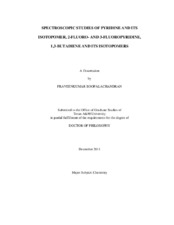| dc.description.abstract | The infrared, Raman and ultraviolet spectra of pyridine-d0 and pyridine-d5 were recorded and assigned with a focus on the low-frequency vibrational modes in the S1(n,pi*) electronic excited state. An energy map for the low-frequency modes was constructed and the data for the v18 mode allowed a highly anharmonic one-dimensional potential energy function to be determined for the S1 excited state. In this S1(n,pi*) state, pyridine is quasi-planar and very floppy with a barrier to planarity of 3 cm^-1.
The infrared, Raman and ultraviolet spectra of 2-fluoropyridine (2FPy) and 3-fluoropyridine (3FPy) have been collected and assigned. For 2FPy about 150 bands were observed for the transitions to the vibronic levels of the S(pi, pi*) state at 38,030.4 cm^-1. For 3FPy more than a hundred absorption bands associated with the S(n,pi*) state at 35,051.7 cm^-1 and about forty broad bands associated with the S(pi, pi*) state at 37,339 cm^-1 were observed. The experimental work was complemented by ab initio calculations and these also provided calculated structures for 2FPy, 3FPy, and pyridine. They showed that the fluorine atom on the ring participates in the pi bonding.
The gas-phase Raman spectra of 1,3-butadiene and its 2,3-d2, 1,1,4,4-d4, and d6 isotopomers have been recorded with high sensitivity in the region below 350 cm-1, in order to investigate the internal rotation (torsional) vibration. The data for all the isotopomers were then fit using a one-dimensional potential energy function of the form V = (1/2)Sigma(Vn(1-cos (phi))). The energy difference between trans and gauche forms was determined to be about 1030 cm^-1 (2.94 kcal/mol), and the barrier between the two equivalent gauche forms to be about 180 cm^-1 (0.51 kcal/mol), which agrees well with high-level ab initio calculations. The results from an alternative set of assignments also fits the data quite well are also presented. Combination and hot band series involving the v13 torsional vibration of the trans rotamer were observed for each of the butadiene isotopomers. In addition, the high signal to noise of the Raman spectra made it possible to detect several dozen bands of the gauche rotor which makes up only about 2% of the molecules at ambient temperature. | en |


